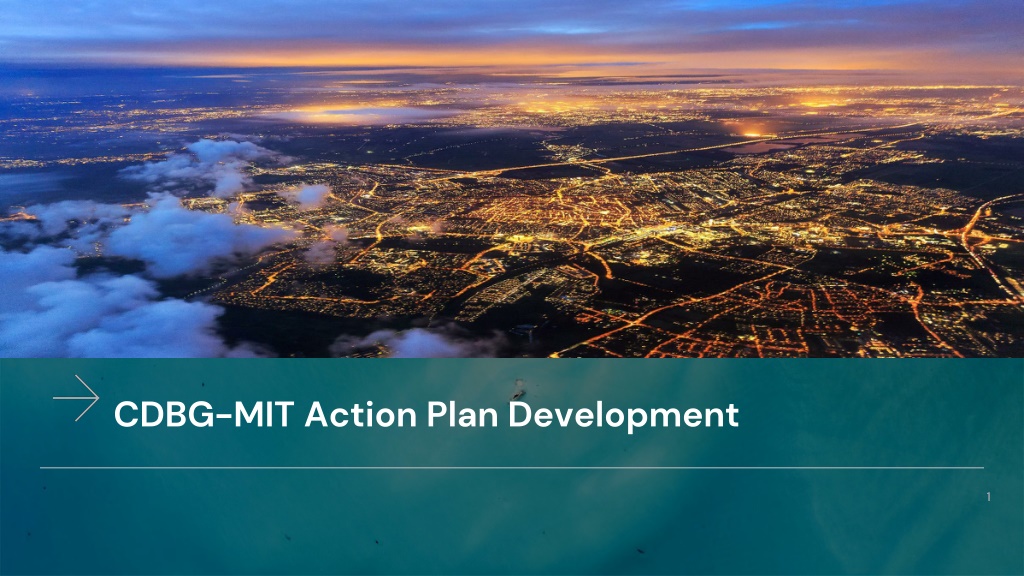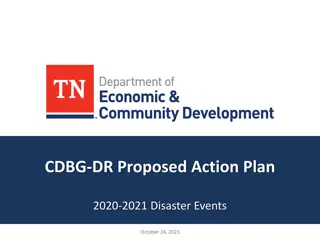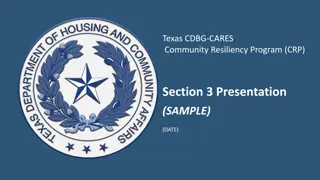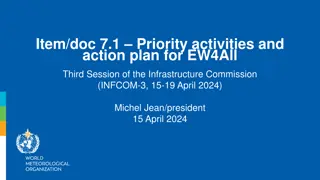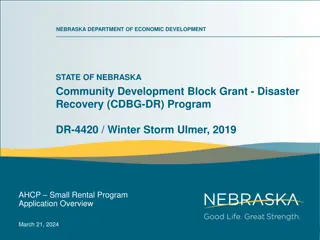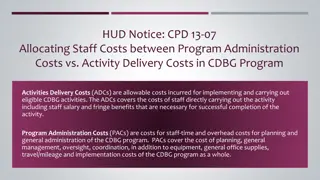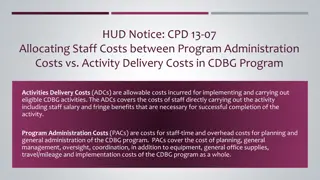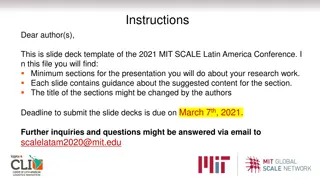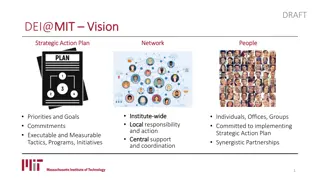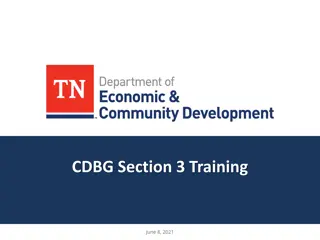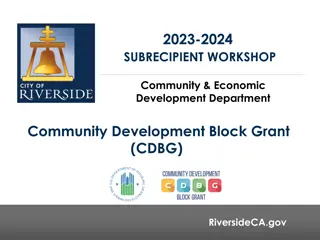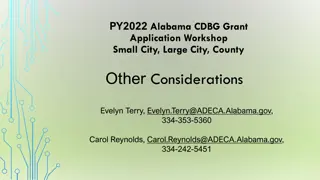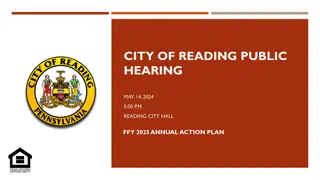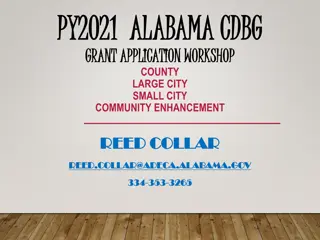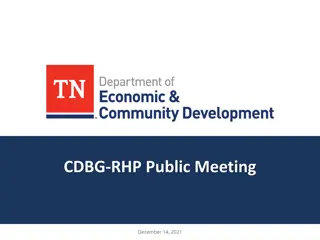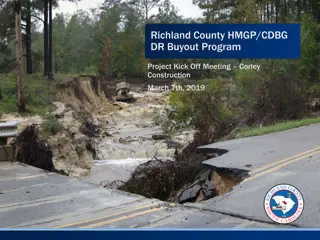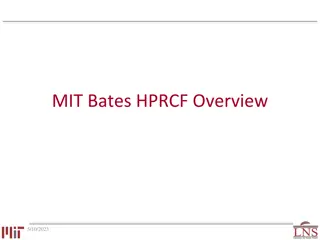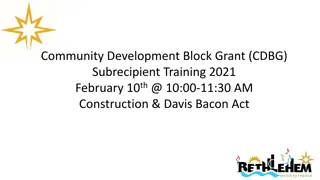Understanding CDBG-MIT Action Plan Development
Grantees participating in the CDBG-MIT Action Plan Development training will learn about the goals, key components, and critical timelines of the program. They will gain insights into mitigation planning, including defining mitigation, purposes, and differentiating between CDBG-MIT and CDBG-DR. The training emphasizes data-informed investments, risk analysis, policy adoption, and maximizing fund impacts through partnerships and coordination.
Download Presentation

Please find below an Image/Link to download the presentation.
The content on the website is provided AS IS for your information and personal use only. It may not be sold, licensed, or shared on other websites without obtaining consent from the author. Download presentation by click this link. If you encounter any issues during the download, it is possible that the publisher has removed the file from their server.
E N D
Presentation Transcript
What You Will Learn from This Training Grantees will understand goals of the CDBG-MIT Action Plan Grantees will better understand the Definition and Purpose of Mitigation Grantees will understand the difference between CDBG-MIT and CDBG-DR Grantees will learn key Components of the CDBG-MIT Action Plan Grantees will learn how to develop a Mitigation Needs Assessment (4 Steps) Grantees will learn about the CDBG-MIT Program Design Grantees will be introduced to General Action Plan Requirements Grantees will learn about Public Participation Grantees will understand Critical Timelines CDBG CDBG- -MIT Action Plan: Training MIT Action Plan: Training
Goals of the CDBG-MIT Action Plan 3
1 1 Support data-informed investments, focusing on repetitive loss of property and critical infrastructure 2 2 Build capacity to comprehensively analyze disaster risks and update hazard mitigation plans Support the adoption of policies that reflect local and regional priorities that will have long-lasting effects on community risk reduction, including risk reduction to community lifelines and decreasing future disaster costs 3 3 4 4 Maximize the impact of funds by encouraging leverage, private/public partnerships, and coordination with other Federal dollars CDBG CDBG- -MIT Action Plan: Goals MIT Action Plan: Goals
Understanding the Definition and Purpose of Mitigation 5
Mitigation Mitigation is any sustained action taken to reduce or eliminate the long-term risk to human life and property from hazards -44 Code of Federal Regulations (CFR) 201.2 Mitigation Planning The purpose of mitigation planning is for Territorial, local, and Indian tribal governments to identify the natural hazards that impact them, to identify actions and activities to reduce any losses from those hazards, and to establish a coordinated process to implement the plan, taking advantage of a wide range of resources -44 CFR 201.1(b) CDBG CDBG- -MIT Action Plan: Mitigation and Mitigation Planning MIT Action Plan: Mitigation and Mitigation Planning 6
How is CDBG-MIT Different from CDBG-DR 7
CDBG CDBG- -DR vs CDBG DR vs CDBG- -MIT Program Program Purpose Purpose MIT Basis of Plan Basis of Plan Projects Projects CDBG CDBG- -DR DR Dedicated to Recovery Recovery (After an Event) (After an Event) Assessment of Unmet Needs Identify gaps in recovery assistance for housing, infrastructure, economic development, and planning CDBG CDBG- -MIT MIT Increase Resilience Resilience (Before an Event) (Before an Event) Risk-based needs assessment (Hazard Mitigation Plan) Reduce or eliminate the long-term risk of loss of life, injury, damage to and loss of property, and suffering and hardship, by lessening the impact of future disasters. Factor in FEMA's Seven Community Lifelines CDBG CDBG- -MIT Action Plan: CDBG MIT Action Plan: CDBG- -DR and CDBG DR and CDBG- -MIT Comparison MIT Comparison 8
Key Components of the CDBG-MIT Action Plan 9
CDBG-MIT Action Plan Key Components #1 Risk-Based Needs Assessment #2 Impacts to Community Lifelines and Vulnerable populations #3 Program/Project design to mitigate future risk and LMI prioritized #4 Program/Project budgets ensuring 50% of expenditure is for LMI #5 HUD-required general information CDBG-MIT Action Plan: Key Components 10
The Foundation of the CDBG-MIT Action Plan is the Mitigation Needs Assessment 11
Developing a Mitigation Needs Assessment oStep 1 Step 1: Reach out to partners and local stakeholders oStep 2 Step 2: Consult with the agency administering the Hazard Mitigation Plan oStep 3 Step 3: Review the Grantee s Hazard Mitigation Risk Assessment oStep 4 Step 4: Develop the CDBG-Mitigation Needs Assessment CDBG CDBG- -MIT Action Plan: Developing a Mitigation Needs Assessment MIT Action Plan: Developing a Mitigation Needs Assessment
Step 1: Identify key agencies and stakeholders to create partnerships to collect, share, and assemble critical information and input FEMA (all Hazard Mitigation Resources) The U. S. Army Corps of Engineers (USACE) The U. S. Forestry Service National Interagency Coordination Center (NICC) Governor s Office of Planning and Research Hazard Mitigation Plan Emergency Services (Police, Fire, EMS, Emergency Management Offices, etc.) Local and Regional Planning Offices U. S. Department of Energy Office, Office of Energy Policy and Systems Analysis NOAA Center for Disease Control (CDC) Private Sector U. S. Navy Base Chamber of Commerce CDBG CDBG- -MIT Action Plan: Mitigation Needs Assessment Step 1 MIT Action Plan: Mitigation Needs Assessment Step 1
Step 2: Consult Potential Partnering/Collaborating agencies regarding the Hazard Mitigation Plan and any mitigation planning or projects underway Goals: Goals: 1) To discuss the most recent HMP 2) To address significant risks included in the HMP. 3) To discuss the impacts of these risks at the lowest geographic level possible. 4) To identify the Coordination Structure used among these agencies that: Defines leadership roles, Explains the communication and coordination process for mitigation planning. 5) Build a foundation for on-going mitigation collaboration and coordination across funding streams. CDBG CDBG- -MIT Action Plan: Developing a Mitigation Needs Assessment Step 2 MIT Action Plan: Developing a Mitigation Needs Assessment Step 2
Step 3: Review the risk assessment associated with the HMP and use the risks identified as a starting point for a Mitigation Needs Assessment Review the Hazard Mitigation Plan Identify Hazards in the HMP. Identify Greatest Risk Profile of the Territory Historic Damage Patterns and Storms, Current and Future Risks Identify Data Sources, Research and Analytics sourced throughout the document. Identify Assets discussed in the document. State-owned and leased buildings Natural Environment Economy Populations Built Environment (are the Community Lifelines addressed?) Understand the Intersection of the Community Lifelines and Hazard Mitigation. Identify Social Vulnerabilities. Review the Risk Analysis. CDBG CDBG- -MIT Action Plan: Review the Hazard Mitigation Assessment Step 3 MIT Action Plan: Review the Hazard Mitigation Assessment Step 3
Review Risk Analysis: Risk should be assessed using the following data. CDBG CDBG- -MIT Action Plan: Review Risk Analysis Step 3 MIT Action Plan: Review Risk Analysis Step 3 16
Categorize Risk Assessment Methodologies: - Exposure/GIS Analysis hazards with geographic areas of known risk - Historical Analysis hazards with a repository of historical data - Scenario Analysis hazards with no defined pattern, geography, or historical record - Combination of methods Future Risk Assessment: - Risk is not static over time - Risk assessments must include a description of future hazard probabilities - Future climate and weather patterns: MUST be included in State risk assessments Address Social Vulnerability Clearly identify and address the risks associated with the 7 Community Lifelines CDBG CDBG- -MIT Action Plan: Review Risk Analysis Step 3 MIT Action Plan: Review Risk Analysis Step 3
FEMA Community Lifelines FEMA Community Lifelines Safety and Security Energy (Power and Fuel) Communications FEMA s community lifelines (i.e., those services that enable the continuous operation of critical government and business functions and are essential to human health and safety or economic security) are the integrated network of assets, services, and capabilities that are used day-to-day to support the recurring needs of the community Hazardous Material (Management) Food, Water, and Sheltering Health and Medical Transportation CDBG CDBG- -MIT Action Plan: Mitigation Needs Assessment MIT Action Plan: Mitigation Needs Assessment- -Community Lifelines Step 3 Community Lifelines Step 3
FEMA Community Lifelines Intersect Hazard Mitigation Planning Community Development and Land Use Planning Natural and Cultural Resource Protection Emergency Management (CEMP, EO, IAP, THIRA) The hazard mitigation planning process lays the foundation for state, territorial, tribal and local governments to look critically at their other planning efforts and align them with mitigation concepts, principles and actions with the goal of building resilience. Hazard Mitigation Planning Stormwater and Floodplain Management Stakeholder Outreach and Engagement Community Wildfire Protection Planning Climate Change Action and Sustainability Building Codes and Infrastructure Planning CDBG CDBG- -MIT Action Plan: Community Lifelines Intersect Hazard Mitigation Planning Step 3 MIT Action Plan: Community Lifelines Intersect Hazard Mitigation Planning Step 3
Step 4: Assessment Successful grantees will do the following: o Document collaboration and coordination among other mitigation projects and agencies o Identify and analyze all significant current and future disaster risks and provide a substantive basis for the activities proposed o Incorporate quantitative assessments into program justifications The following list is a collection of HUD s requirements for a Mitigation Needs Assessment Writing the CDBG Mitigation Needs When developing the CDBG Mitigation Needs Assessment, refer to the Updated CDBG-MIT Action Plan Checklist often to assure every topic HUD lists on the Checklist is addressed Discuss how the risk-based Mitigation Needs Assessment was completed and highlight how the plan identifies and analyzes all significant current and future disaster risks Discuss the most recent FEMA Hazard Mitigation Plan (HMP) [i.e., describe plan and date is it was completed, etc.] o At a minimum, address the risks included in the Territory s HMP o Address whether the HMP requires an updated CDBG-MIT Action Plan: Writing the Mitigation Needs Assessment Step 4 20
Describe impacts of the risks identified at the lowest geographical level possible Cite data sources for all maps, images, tables, etc. throughout the Action Plan Describe impacts to the 7 Community Lifelines for the significant risks identified. Conduct quantitative assessments to demonstrate the significant potential impacts and risks of hazards affecting the 7 Community Lifelines Describe how proposed projects will effectively address risks to indispensable services that enable continuous operations of critical business and government functions that are critical to health and safety and economic security Describe how plans to promote local and regional long-term planning and implementation have been influenced by the Mitigation Needs Assessment - Include in the description of how the Mitigation Needs Assessment informed development and enforcement of building codes and standards (such as wildland urban interface, flood and all hazards, including ASCE-7, as may be applicable), and revised land use and zoning policies - Describe coordination with other planning efforts by local and regional entities to ensure alignment of CDBG- MIT activities with those plans - Describe actions to promote an increase in hazard insurance coverage CDBG CDBG- -MIT Action Plan: Writing the Mitigation Needs Assessment Step 4 MIT Action Plan: Writing the Mitigation Needs Assessment Step 4
If pursuing flood mitigation efforts, describe how high wind and continued sea level rise were considered and based on the history of flood mitigation efforts If pursuing wildfire mitigation efforts, describe how land-use plans, emergency access, landscaping requirements were supplied and considered If pursuing tornado mitigation efforts, describe promoting the construction and use of safe rooms and require/encourage wind engineering measures and construction techniques into building codes Describe how the CDBG-MIT activities will affect protected classes under Fair Housing and Civil Rights laws, racially and ethnically concentrated areas, as well as concentrated areas of poverty. How will it promote resilient affordable housing as well as fair housing choice as it responds to natural disasters? CDBG CDBG- -MIT Action Plan: Developing a Mitigation Needs Assessment Step 4 MIT Action Plan: Developing a Mitigation Needs Assessment Step 4
CDBG-MIT Program Design 23
Projects and Activities - Describe how the Grantee will: - Meet the definition of mitigation activities; - Address the current and future risks as identified in the grantee s Mitigation Needs Assessment of MIDs; - Document how proposed activities are CDBG-eligible activities under Title 1 of the Housing and Community Development Act; - Describe how activities will meet a national objective, including additional criteria for mitigation, and Covered Projects (if applicable) Bases for Allocations: - Describe how the Action Plan will prioritize programs and projects that will protect LMI persons in order to meet the overall benefit requirement (50% LMI) - Describe the substantive basis for the proposed activities: Include a chart or table that illustrates at the most practical levels how all funding is budgeted (e.g., by program, subrecipient, territory-administered activity, or other category) Ensure that the amounts for all activities add up correctly, equal amount allocated, and are consistent throughout the plan CDBG CDBG- -MIT Action Plan: Program Design MIT Action Plan: Program Design
Develop Budget: Ensure that at least 100% of activity funds are used to mitigate risks within the MIDs Ensure that budget allocates at least 50% to support activities benefiting LMI Note: Flood Mitigation, Fire Mitigation, and Tornado Mitigation only need to be addressed if pursuing these types of mitigation activities For each program or activity carried out by the Grantee, the following information is required (84 FR 45849): (a)Are threshold factors and grant size limits applied? (e) Is the criteria and relative importance of each criterion when selecting applications for funding Included within the plan? (b) Are the projected uses of the CDBG-MIT funds, by responsible organization, activity, and geographic area included? (c) Demonstrate how the projected use will meet CDBG eligibility criteria and associated national objective(s), including additional criteria? (d) When sub-granted to local governments or Indian tribes, is the criteria and relative importance of each criterion to distribute the funds provided? CDBG CDBG- -MIT Action Plan: Program Design MIT Action Plan: Program Design
CDBG-MIT General Action Plan Requirements 26
Application Status: - Describe multiple methods of communication, such as websites, toll-free numbers, or other means that provide applicants with timely information to determine the status of their application Substantial Amendment Substantial Amendment: Ensure the Action Plan defines what constitutes a Substantial Amendment - At a minimum, the Action Plan must include how the following will be defined for substantial amendment: Cover Project Change in program benefit or eligibility criteria Allocation or reallocation of funds with a monetary threshold Promote Housing for Vulnerable Populations: Describe how the programs or projects increase the resiliency to housing - How does it increase resiliency for housing that serves vulnerable populations, including transitional housing, permanent supportive housing, permanent housing serving individuals, and families that are homeless and at-risk of homelessness, and public housing developments? CDBG CDBG- -MIT Action Plan: General Action Plan Requirements MIT Action Plan: General Action Plan Requirements
Minimize and Address Displacement: Describe how the Grantee will minimize displacement of persons or entities displaced through its mitigation activities (except for the mitigation through voluntary buyout activities that are designed to move households out of harm s way) Maximum Assistance and Cost Reasonableness: Include a description of the maximum amount of assistance available to a beneficiary under each of the mitigation programs. Describe Exceptions process for awards Elevation Standards: Describe how elevation standards for new construction, repair of substantially damaged structures, or substantial improvements to residential structures in flood hazard areas will be elevated to at least 2 ft. above the 1% annual floodplain elevation (or ABFE +2). - If not, did the Grantee choose the ASCE-24 standards for elevation if it results in elevation 2+ ft. above base flood elevation? Construction Standards: Describe how construction standards will reduce the risk of loss of life and property from future disaster and yield community development benefits Describe how construction standards will emphasize quality, durability, energy efficiency, high winds, storm surge, and flooding CDBG CDBG- -MIT Action Plan: General Action Plan Requirements MIT Action Plan: General Action Plan Requirements
Construction Standards (cont) - Describe application of green building standards - Describe adherence to advanced elevation requirements - Describe adoption and enforcement of modern and/or resilient building codes and mitigation of hazard risk, including possible sea level rise, high winds, storm surge, and flooding Describe how the Grantee will encourage Green Building Standards for the following: - All new construction of residential buildings - All replacement of substantially damaged residential buildings - How, to the extent applicable, the Territory will comply with the HUD CPD Green Building Retrofit Checklist CDBG CDBG- -MIT Action Plan: General Action Plan Requirements MIT Action Plan: General Action Plan Requirements
National Objectives Ensure that all activities meet a national objective If using a slum/blight national objective, explain approval from HUD Ensure that each Urgent Need Mitigation (UNM) national objective references current and future risks as identified in the Grantee s Needs Assessment of the MIDs? Are the impacts in the Needs Assessment? Ensure each activity using UNM demonstrates how it will result in a measurable and verifiable reduction in the risk of loss of life and property Operations and Maintenance Describe the Grantee s plan for long-term operation and maintenance of the infrastructure and public facility projects. Include a description of how it will fund long-term operation infrastructure and maintenance for CDBG-MIT Describe any proposed changes to existing taxation policies or tax collection practices that must take place to support the operations and maintenance If using any State or local resources for operations and maintenance, please describe CDBG CDBG- -MIT Action Plan: General Action Plan Requirements MIT Action Plan: General Action Plan Requirements 30
Grant Management Cost Verification Describe the Grantee s controls for assuring that construction costs are reasonable and consistent with market costs at the time and place of construction Address controls for CDGB-MIT infrastructure projects above a certain project cost threshold identified by the grantee and for the Covered Projects as defined for CDBG-MIT funds Timely Expenditures: Describe how monthly expenditures are tracked Describe how Subrecipient expenditures will be monitored Describe how program income will be managed Describe how funds will be reprogramed in a timely manner for stalled projects Provide projections for all CDBG-MIT funds Describe how contracts and bills will receive timely payment Describe how actual and projected expenditures of funds will be accurately reported CDBG CDBG- -MIT Action Plan: General Action Plan Requirements MIT Action Plan: General Action Plan Requirements 31
Projections for Expenditures and Performance Outcomes Provide expenditure projections showing how the Grantee will expend at least 50% of its allocation in 6 years and 100% in 12 years Note: HUD Action Plan Checklist items #86 and #87 only need to be addressed if spending funds outside of the MIDs CDBG-MIT Certifications - Include with Action Plan submittal and have signed by Chief Executive Office SF-424 - Include completed and executed SF-424 form CDBG CDBG- -MIT Action Plan: General Action Plan Requirements MIT Action Plan: General Action Plan Requirements
Public Participation 33
Public Participation Develop a CDBG-MIT webpage that is linked to your CDBG-DR webpage Hold a public hearing to introduce citizens to the mitigation purpose of the CDBG- MIT funds during the development of the Action Plan and prior to posting actual Action Plan on the website Document the Action Plan posting on the official website (with topic disaster mitigation navigable from the homepage of the relevant agency) While the Action Plan is posted for public comment, schedule a 2nd public hearing on the actual posted Action Plan Post Action Plan for at least 45 days allowing reasonable opportunity for citizens, affected local governments and other interested parties an opportunity to comment Document how the plan was accessible to all including person with disabilities and non-English speaking persons CDBG CDBG- -MIT Action Plan: Public Participation MIT Action Plan: Public Participation
Establish a Citizen Advisory Group following approval of the Action Plan by HUD The group must: Meet in an open forum at least two times a year Serve as an on-going public forum to continuously provide feedback on the CDBG-MIT projects and programs Solicit and respond to public comments about CDBG-MIT activities Public Participation: Citizen Advisory Committee Public Participation: Citizen Advisory Committee 35
Critical Timelines As with any project, time management is critical to managing processes, tasks, and milestones and deadlines. The following is a sample timeline that can be modified to assist your specific project: 36
Critical Timelines Example Timeline for CDBG-MIT Action Plan Submittal Week Dates 1 2 3 4 5 6 7 8 9 10 11 12 13 14 15 16 17 18 Action Item Amend Citizen Participation Plan to Include CDBG-MIT Requirements Consult with Stakeholders Complete Risk-Based Mitigation Analysis Design Program(s) that Address highest risk Complete all other required sections of the AP Color Key Critical Deadlines Pre-Action Plan Activities Risk Assessment Activities Complete AP draft and send for translation (if applicable) Publish public notice for pre- releast public hearing Pre-Release Public Hearing Update Financial Certs for CDBG- MIT (Date TBD) Update Policies&Procedures Publish public notice for publication of AP, public comment period, and post-release hearing Publish AP and post on website P&Ps Action Plan Development Implementation Plan/Capacity Assessment/Projections Citizen Participation Public Hearings 45-Day Public Comment Period Begins Complete Implementation Plan, Capacity Assessment, Projections of Expenditures and Accomplishments Post-Release Public Hearing Public Comment Period Ends Summarize Comments and Provide Responses to Comments Complete SF-424 forms and Certifications Submit Action Plan, Capacity Assessment, Implementation Plan, and Budget Projections, SF-424, and Certifications to HUD CDBG CDBG- -MIT Action Plan: Critical Timelines MIT Action Plan: Critical Timelines
Thank you and Questions? 38
